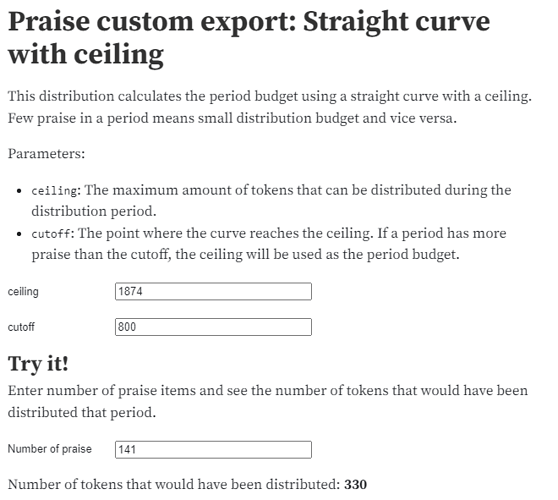Challenge: When the TEC token distribution was determined, the volume of Praise was significantly higher than it is now. Over the past 10 months, Praise volume has dropped by over 90% as of the last period. However, as the distribution was set as a static volume, we are distributing the same quantity of TEC (1,874 per 2 week period) for a significantly smaller volume of praise dished.
Planned Approach: Implement a mechanism to dynamically adjust the rewards distributed for a period to correspond to the amount of Praise being dished. The method of determining the distribution would be based on a linear equation that defines two things:
- The maximum amount of tokens to distribute (ceiling)
- The instances of praise needed to acquire maximum rewards (cutoff).
We chose a ceiling based on the historical peak count of Praise incidents, while maintaining the ceiling at our current rate of distribution. Here’s our parameters:
TEC Ceiling: 1,874 (same as current distribution)
Praise Instances Cutoff: 800 (~91% of historical peak of praise dished bi-weekly)
Rewards Distribution can be simulated by inputting period instances of Praise to this tool: https://observablehq.com/@kristofer/praise-straight-curve-with-ceiling
**credit to @kristoferlund for developing the tool
However it’s already been built into RAD and would be ready to use immediately in our current processes.
**Credit to @0xNuggan for implementing it
Example: In Period 19 there were 141 incidents of Praise. Using the tool linked above with the Ceiling and Cutoff values proposed, the Reward Distribution would be 330 TEC.
Benefits: Provide some sort of feedback to the distribution process based on utilization of the Praise system. As a secondary benefit, extend the lifespan of the rewards pool.
Alternatives considered: As an alternative to instances of Praise, we tried looking at the total value of all Praise in a round to calculate the distribution. Using the example above, the distribution above using this method would have only distributed 170 TEC in period 19.
